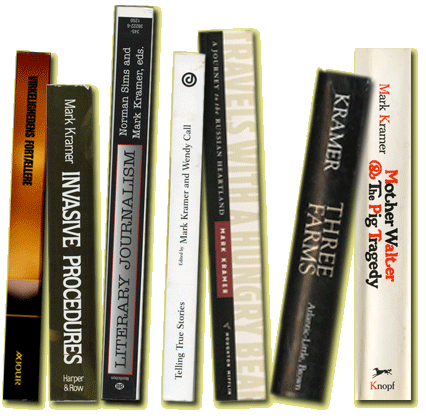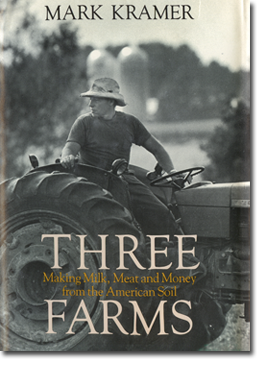
Click on a book to read its review.

Click on a book to read its review.
THREE FARMS: MAKING MILK, MEAT & MONEY FROM THE AMERICAN SOIL
By Mark Kramer
Atlantic/Little Brown, 1980. 274 pp.
Review by: Noel Perrin
RURAL LIVES
New York Times Sunday Book Review
3/30/1980
The world keeps getting richer. Things that used to be done on a shoestring now command vast budgets. Last winter provided a stunning example. The 1932 Olympics at Lake Placid had total gate receipts of $94,000; the 1980 replay had a gate from television alone of $15.5 million.
Or take military expenditures. In 1932, the United States ran its armed forces on about a quarter of a percent of the sum it will spend this year. Expectations were almost pitifully modest back then. The Army was pleased with itself for having 12 new tanks—new in the sense that they’d been acquired after World War I. In 1980, we give away more stuff than that every month or two.
A similar phenomenon has occurred in the world of journalism. Until quite recently, a good journalist simply didn’t have the time or money to investigate a subject deeply. No book he was going to write, except maybe one assigned by an editor on a ready-made topic, would sell enough to repay him for his time, his travel, his research.
Prosperity has changed that. Over the past generation, a while group of writers has discovered that it’s possible to put several years into a subject that no one would even know mattered until the book came out. Joseph Mitchell on what’s at the bottom of New York harbor, Boyd Gibbons writing “Wye Island” and John McPhee encountering archdruids would be fair examples. Books like theirs are the true “new journalism.” What’s new is not the use of novelistic technique, but the use of truly exhaustive research, the shift from quick and easy reporting to the complete tracing of an ecosystem.
Mark Kramer’s “Three Farms” is a distinguished addition to this genre. Like many young Americans, Mr. Kramer moved to the country a dozen years ago. He bought an abandoned farm and restored it. But instead of writing another cute story about his adventures with chickens and shaky barns, he gradually took on a far more ambitious project. He set out to understand why there are so many abandoned farms in America, what forces are shaping—and misshaping—our agriculture. This book is his report.
The three farms Mr. Kramer writes about are both real places and intensely symbolic. One is an unusually successful dairy farm in Massachusetts, a family farm still thriving when most family farms are doomed to fail. (Most in Massachusetts already have failed; there are 4,000 left in a state with five and a half million people.) The one he describes has survived through a combination of good land, hard work and real genius on the owner’s part in forcing more milk out of his cows. As an unintended byproduct, he is also forcing his neighbors out of business.
The second place is much larger, a typical Iowa farm specializing in hogs, corn and machinery. And the third farm is 21,000 acres of automation in California, a corporation owned by another corporation owned by a third corporation that in turn is largely owned by the Chandler family of Los Angeles. This one doesn’t so much grow as manufacture what pass for tomatoes in this country, along with almonds, grapes, cotton, garlic, and so forth. All on pubic water.
Roughly speaking, these farms are the past, present and future of American agriculture. Mr. Kramer has lived on all three of them. He knows exactly what genetic-engineering men have done to produce the deformed but still-living milk machines that modern dairy cattle are. He knows what market forces require an Iowan to keep his pigs in a permanent state of severe stress from overcrowding. (Because plant costs are a large part of the cost of hog farming, you allot three to eight square feet of living space for animals that grow larger than human beings.) And what requires him to raise corn on land that he knows perfectly well should be kept in grass. (The brief answer is that most Iowa farmers are not sharecroppers on part of their land—and the absentee owner, whether Chicago dentist or Belgian investment banker, wants the instant $100 an acre you get from corn, whether it hurts the land or not. If a conscientious farmer refuses, the owner finds someone else. That’s why Iowa hillsides currently lose 13 tons of topsoil per acre per year.)
Moving west, Mr. Kramer understands agribusiness too. He can explain the use of lasers in laying out a modern California vineyard, or the reason why a farmer as opposed to a corporation can no longer hope to get a tomato contract in America. Farmers aren’t big enough, he explains, to fulfill contracts on the 1980 scale. Some of them can sell better tomatoes for less money than the corporations do—but the big buyer can’t be bothered with the couple of million tomatoes a farmer might produce. On the corporate scale, stability of output is more important than either quality or price.
Mr. Kramer does two remarkable things in this book. One is to capture the true feel of country life in a high-technology era. Most writing about the country is an exercise in one form or another of nostalgia, but this book is a vivid and exact account of what really happens. Such a scene as Mr. Kramer’s description of night harvesting in California—with the floodlights mounted on towers and machines straight out of science fiction, the row-crops supervisor talking on a mobile telephone and a repair crew rumbling across the field in the same kind of truck that services jets—shows a fine ear for American speech and a fine eye for detail. Mr. Kramer can be sad, funny and incisive in a single paragraph. The book reads as well as the best McPhee or Mitchell.
Mr. Kramer’s other triumph is to see what scarcely anyone else has seen so clearly: that the villain in the destruction of rural life is not Earl Butz, or cold-hearted agribusinessmen or greedy distributors, but simply the capital-intensive nature of technology itself. Technology has laid the same metal hand on the country that it has on armies and on the Olympics (where competitors stayed in Vermont and commuted to and from Lake Placid by helicopter). No one meant agriculture to change in quite the way it has, and those who stood to lose most from its having happened did most to bring it about. They did it by being the best farmers.
“We lost country life when we moved to tractors,” an old Iowan told Mr. Kramer once, a man whose nephew now farms with six tractors, a combine, a bulldozer, two balers—almost enough equipment to outfit our entire Army in 1932. It’s not enough, however, to assure that the farm will survive the 80’s.
What we are about to lose next, Mr. Kramer thinks, is the free market in food itself, the power of the consumer to determine what will appear in stores. The loss of rural life doesn’t affect most Americans much; the loss of the free market in food will. “The experience of supermarketing in Massachusetts, Iowa, and California, and finding the same brands from the same suppliers on sale coast to coast brings home the message,” Mr. Kramer writes at the end of his book. America has “a food production chain increasingly dominated in input, processing, and marketing aspects by a few powerful financial forces.”
When that domination is complete, Mr. Kramer thinks, consumers will have the same choice in food that they now have in winter tomatoes—that is, no choice at all. It’s a gloomy message, but one told in an enthralling book. A book that might even do something to modify that future. Which suggests that however bad economic concentration has been for farmers, it’s been good for journalists.
